| Tule elk | |
|---|---|
 | |
| Tule elk bull at San Luis National Wildlife Refuge | |
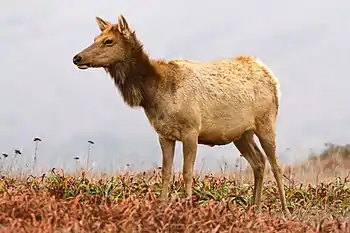 | |
| Tule elk cow at Tomales Point, Point Reyes National Seashore | |
| Scientific classification | |
| Domain: | Eukaryota |
| Kingdom: | Animalia |
| Phylum: | Chordata |
| Class: | Mammalia |
| Order: | Artiodactyla |
| Family: | Cervidae |
| Subfamily: | Cervinae |
| Genus: | Cervus |
| Species: | |
| Subspecies: | C. c. nannodes |
| Trinomial name | |
| Cervus canadensis nannodes (Merriam, 1905) | |
| Synonyms | |
|
Cervus elaphus nannodes | |
.jpg.webp)
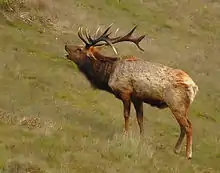
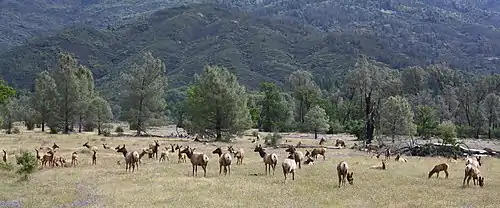
The tule elk (Cervus canadensis nannodes) is a subspecies of elk found only in California, ranging from the grasslands and marshlands of the Central Valley to the grassy hills on the coast.[2] The subspecies name derives from the tule (/ˈtuːliː/), a species of sedge native to freshwater marshes on which the Tule elk feeds. When the Europeans first arrived, an estimated 500,000 tule elk roamed these regions, but by 1870 they were thought to be extirpated.[2] However, in 1874–1875 a single breeding pair was discovered in the tule marshes of Buena Vista Lake in the southern San Joaquin Valley.[3] Conservation measures were taken to protect the species in the 1970s.[4] Today, the wild population exceeds 4,000.[5] Tule elk can reliably be found in Carrizo Plain National Monument, Point Reyes National Seashore, portions of the Owens Valley from Lone Pine to Bishop, on Coyote Ridge in Santa Clara Valley, San Jose, California and in Pacheco State Park and areas surrounding San Luis Reservoir near Los Banos, California.
Description
Considered the smallest of the elk subspecies in North America, the tule elk were the dominant large ungulate in California prior to the arrival of the Spanish. The average weight of adult males is only 450 to 550 lb (200 to 250 kg) and females have an average of 375 to 425 lb (170 to 193 kg). Although tule elk have been reported as half the size of the Roosevelt elk (C. c. roosevelti), and sometimes referred to as the dwarf elk, this moniker may be misleading as the smaller size of some tule elk may reflect poor nutrition of elk subsisting on marginal habitat such as the Owens River watershed. California Department of Fish and Wildlife records show recent tule elk bulls on Grizzly Island in Suisun Bay weigh up to 900 pounds (410 kg).[6] This is a similar size to Roosevelt elk bulls which weigh between 700 pounds (320 kg) and 1,100 pounds (500 kg).[7] Wildlife biologist Dale McCullough described an elk transplanted from Buttonwillow in the San Joaquin Valley to a golf course in Monterey that grew to the size of a Rocky Mountain elk.[8] Also hunter H. C. Banta described the tule elk in the 1850s as "I found no difference in size between these elk and the Oregon, Washington, Wyoming and Colorado elk, and felt sure that the bulls would weight 700 to 800 pounds".[6]
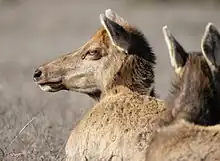
The calves are similar to deer fawns, with brown coats and white spots.
Tule elk herd size likely numbered in the several hundreds historically. Joseph Warren Revere, the grandson of Revolutionary War patriot Paul Revere, wrote in his book Naval Duty in California that he counted 400 elk in a single herd on Pt. Reyes in the 1840s.[9] Stephen J. Richardson, son of Marin County pioneer Captain William A. Richardson, wrote "I think the largest herd in the world roamed over the deep grasslands of Point Reyes...I fully believe there were a thousand elk in one herd."[10] General John Bidwell of the 1841 Bartleson–Bidwell Party wrote: "In some of the fertile valleys, such as Napa and Santa Clara, there were elk literally by the thousand".[11]
Genetic studies based on mitochondrial and nuclear DNA confirm that tule elk, Roosevelt elk and Rocky Mountain elk should be considered distinct subspecies.[12][13] A 2007 nuclear DNA microsatellite study found single alleles at many loci, with a maximum of five alleles at one locus, indicating that there has either been a mutation at this locus subsequent to the single breeding pair reported by Henry Miller and nineteenth century game warden A. C. Tibbet, or there were three surviving tule elk at the 1800s genetic bottleneck.[13] Another microsatellite study in 2016 found no more than four alleles at any locus, consistent with tule elk having been reduced to a single breeding pair.[14]
History
The first European explorer to see tule elk was likely Sir Francis Drake who landed in July 1579 probably in today's Drake's Bay, Marin County, California: "The inland we found to be far different from the shoare, a goodly country and fruitful soil, stored with many blessings fit for the use of man: infinite was the company of very large and fat deer, which there we saw by thousands as we supposed in a herd..."[8] A more definitive second encounter 16 years later was described by Sebastian Rodriguez Cermeño, who was shipwrecked in December 1595, and in Drake's Bay with certainty. Cermeño's account described "deer walking about, the largest ever found, as could be seen by the antlers, of which the Captain carried away a sample". On a trip inland they found "a great quantity of deer horns, one of which, measured before this witness, showed sixteen palmas [11 feet] from point to point."[15] Cermeno and his crew made a small boat from their wrecked Manila galleon and sailed back to Acapulco, Mexico, with but a single trophy of their voyage to the Philippines, the set of large elk antlers.[16] Next, Sebastián Vizcaíno described seeing elk on his December 1602 exploration of the Monterey area, "Among the animals there are large, fierce bears, and other animals called elks, from which they make elk leather jackets."[17] When Richard Henry Dana Jr. visited San Francisco Bay in 1835, he wrote about vast elk herds near the Golden Gate on December 27: "...we came to anchor near the mouth of the bay, under a high and beautifully sloping hill, upon which herds of hundreds and hundreds of red deer [note: "red deer" is the European term for "elk"], and the stag, with his high branching antlers, were bounding about...", although it is not clear whether this was the Marin side or the San Francisco side.[18]
The arrival of the Spanish in the late 18th century introduced cattle and horses to the grasslands of the Central Valley, competing with the native elk. Unrestricted hunting further reduced the herds. By the time elk hunting was banned by the State Legislature in 1873, the tule elk was believed to be extinct.[19]
California cattle baron Henry Miller protected tule elk after a pair was discovered on his ranch in the tule marshes near Buena Vista Lake by game warden A. C. Tibbett in 1874. Miller ordered his men to protect the elk and is credited for the survival of the subspecies.[19] After his death, the huge Miller-Lux ranch was subdivided and the hunting of the elk resumed. The population was reduced to 72 head. By 1895, habitat loss and poaching had reduced the elk population to only 28.[5] In the years that followed, the elk were transplanted 21 times, with each attempt failing to establish free-ranging herds.[20]
In 1933, rancher Walter Dow took a small group of penned elk from Yosemite to his ranch in Owens Valley, east of the Sierra Nevada.[20] Although not native habitat for the elk, they thrived. In the same year, the state put a small herd at Cache Creek. This herd has not fared well due to poor range conditions. This herd may have interbred with the Rocky Mountain elk which were introduced near Mount Shasta.
In 1960, the state held a hearing in Owens Valley to determine how many elk should be allowed to live there. They decided the elk should be hunted to limit their numbers to under 500 animals. Through efforts of the California Department of Fish and Game, three permanent elk herds were established in California. By 1969, the Tupman State Reserve (32), Cache Creek (80) and Owens Valley, Inyo County (300 elk) were in place.[8][21]
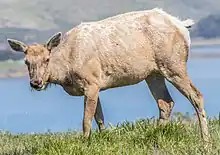
A private citizen from Los Angeles, Beula Edmiston, formed a group to attempt a preservation program for the elk. After more than 10 years of lobbying both on the federal and state levels, in 1971, California passed legislation (the Behr bill) requiring the elk may not be hunted until their numbers surpass 2,000 head statewide or until it could be determined that suitable elk habitat no longer existed in the state, and mandated the California Department of Resources to reintroduce the elk into former habitats wherever possible.[20]
In 1976, the US Congress passed a resolution which stated 2000 tule elk is an appropriate national goal, and directed federal agencies to make federal lands available for preservation of tule elk.[22] An Interagency Task Force[23] of representatives from the National Park Service, US Forest Service, the Armed Forces, Bureau of Land Management, California Department of Parks and Recreation, and the California Department of Fish and Game[24] selected sites for the reintroduction of tule elk within the state. A herd was established at the San Luis Wildlife Refuge in 1974, and elk were released at the Concord Naval Weapons Station in 1977. In 1978, herds were established at Mount Hamilton in Santa Clara County, Lake Pillsbury in Lake County, Jawbone Canyon in Kern County, Point Reyes National Seashore, Fort Hunter Liggett Military Reservation, and Camp Roberts.[25]
Historic range and current population

McCullough identified nineteenth century tule elk antler specimens collected in three separate locations north of the San Francisco Bay: Sonoma in Sonoma County, as well as San Geronimo and Tomales both in Marin County.[8]
By 1986 numbers had increased to over 2,000 individuals distributed among 22 populations throughout California, largely due to successful reintroduction programs.[3] By 1998, California's tule elk population exceeded 3,200.[2][26] In 2007, the statewide population was estimated at 3,800.[27] A 2014 report placed the statewide population at 4,200 in 22 herds.[28] As of 2019, the total Californian population was estimated to be 5,700.[29]
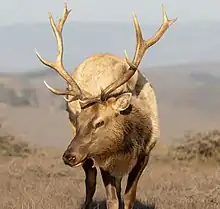
Small numbers of tule elk in Point Reyes have tested positive for Mycobacterium avium subspecies paratuberculosis or "MAP", a wasting disease known as Johne's Disease. The bacteria was apparently transmitted by dairy cattle or spraying of cattle manure on pasturelands. In 2016 more tule elk tested positive after being euthanized so that their gut tissue could be analyzed. Cattle transmitted the disease to the Tomales Point elk herd shortly after they were first established there in 1978.[30]
Diet and impact on native grasslands
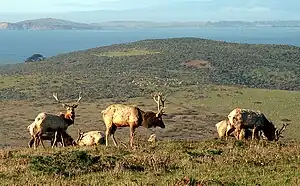
Two male and eight female elk were translocated from Merced County, California to Tomales Point on Point Reyes National Seashore in March 1978. The elk showed signs of nutritional stress including copper deficiency and antler anomalies by summer 1979 and two elk died. One explanation was molybdenum which expresses as copper deficiency. A former molybdenum mine existed in that area of the Point Reyes National Seashore. Other possible explanations include failure to remove cattle until 1979 and the fact that 1977 and 1978 were drought years. Birth rates remained negligible until 1981, when they began reproducing at predicted maximum rates. Studies of fecal material documented that the tule elk preferred grasses and forbs with little use of shrubs such as willow.[31] These results are consistent with findings on the Diablo Range, Santa Clara County elk herd where more than 50% of the tule elk diet were grasses.[32]
A 2007 study at the Tomales Point Elk Reserve showed that tule elk appear to play a critical role in preventing succession of open grasslands to less diverse, shrub-dominated ecosystems. Elk grazing had a positive impact on native grassland species abundance and diversity, and seemed to increase the richness and abundance of some exotic taxa while reducing Holcus lanatus—a highly invasive exotic grass which is a major problem in mesic perennial grasslands.[33]
See also
References
- ↑ NatureServe. 1988. Cervus elaphus nannodes, Tule Elk. NatureServe, Arlington, Virginia. Available https://explorer.natureserve.org/Taxon/ELEMENT_GLOBAL.2.103199/Cervus_elaphus_nannodes. Accessed 9 December 2021.
- 1 2 3 Linse, Kim (1998). "Tule Elk: The Return of A Species" (PDF). National Park Service. Archived (PDF) from the original on 2013-10-17.
{{cite magazine}}: Cite magazine requires|magazine=(help) - 1 2 D.R. McCullough; J. K. Fischer; J. D. Ballou (1996). D.R. McCullough (ed.). From bottleneck to metapopulation: recovery of the tule elk in California, in Metapopulations and wildlife conservation. Covelo, California: Island Press. pp. 375–403. ISBN 978-1-55963-458-8.
- ↑ Brick, Michael (2009-01-06). "Bow Hunters' Quest: Stalking an Elk and a Record". New York Times. Retrieved 2010-05-26.
- 1 2 Kanewske, Rachel. "The Biogeography of the Tule Elk". San Francisco State University.
- 1 2 Laura Cunningham (2010). A State of Change: Forgotten Landscapes of California. Heyday. p. 350. ISBN 978-1-59714-136-9.
- ↑ Robb, Bob (January 2001). The Ultimate Guide to Elk Hunting. The Lyons Press. ISBN 978-1-58574-180-9.
- 1 2 3 4 Dale R. McCullough (1969). The Tule Elk, Its History, Behavior, and Ecology, University of California Publications in Zoology. Vol. 88. University of California Press. p. 209. ISBN 978-0-520-01921-8.
- ↑ Joseph Warren Revere (1947). Naval Duty in California. Oakland, California: Biobooks. p. 245.
- ↑ Stephen J. Richardson (1918). James Hepburn Wilkins (ed.). Days of the Dons: Reminiscences of California's Oldest Native Son. San Francisco Bulletin.
- ↑ Rockwell D. Hunt (1942). John Bidwell, Prince of California Pioneers. Caldwell, Idaho: The Caxton Printers, LTD. p. 463.
- ↑ R.O. Polziehn; J. Hamr; F.F. Mallory; C. Strobeck (1998). "Phylogenetic status of North American wapiti (Cervus elaphus) subspecies". Canadian Journal of Zoology. 76 (6): 998–1010. doi:10.1139/z98-026.
- 1 2 E. P. Meredith; J. A. Rodzen; J. D. Banks; R. Schaefer; H. B. Ernest; T. R. Famula; B. P. May (2007). "Microsatellite Analysis of Three Subspecies of Elk (Cervus elaphus) in California" (PDF). Journal of Mammalogy. 88 (3): 801–808. doi:10.1644/06-mamm-a-014r.1. Retrieved 2013-01-20.
- ↑ Benjamin N. Sacks; Zachary T. Lounsberry; Tatyana Kalani; Erin P. Meredith; Cristen Langner (2016). "Development and Characterization of 15 Polymorphic Dinucleotide Microsatellite Markers for Tule Elk Using HiSeq3000". Journal of Heredity. 107 (7): 666–669. doi:10.1093/jhered/esw069. PMID 27638816.
- ↑ Sebastian Rodriguez Cermeño; Henry R. Wagner (1924). "The Voyage to California of Sebastian Rodriguez Cermeño in 1595". California Historical Society Quarterly. 3 (1): 3–24. doi:10.2307/25613599. JSTOR 25613599.
- ↑ Juan Crespí; Alan K. Brown (2001). A Description of Distant Roads. San Diego, California: San Diego State University Press. p. 15. ISBN 978-1-879691-64-3.
- ↑ Barton Warren Evermann (April 1915). "An Attempt to Save California Elk". California Fish and Game. 1 (3): 85–96.
- ↑ Richard Henry Dana Jr. (1840). Two Years Before the Mast. A Personal Narrative. New York: Harper and Brothers. p. 270. ISBN 978-1-4414-0540-1.
- 1 2 Tule Elk State Natural Reserve Brochure (PDF) (Report). California State Parks. Retrieved 2013-01-20.
- 1 2 3 Laura A. Watt (2015). "The Continuously Managed Wild: Tule Elk at Point Reyes National Seashore". Journal of International Wildlife Law & Policy. 18 (4): 289–308. doi:10.1080/13880292.2015.1096159. S2CID 86127098.
- ↑ Mayer, Steven (February 5, 2019). "Wildlife officials use helicopters to capture 19 tule elk in west Kern for relocation project". The Bakersfield Californian. Retrieved 2021-04-10.
- ↑ The Tule Elk in California, Bureau of Land Management, PL 94 389 March 1980
- ↑ A Management Plan for the Conservation of Tule Elk, The Tule Elk Interagency Task Force, June 1979
- ↑ Tule elk in California-report to the legislature, May 1978, Resources Agency, Dept. of Fish and Game
- ↑ Sabalow, Ryan (August 8, 2019). "Feds plan to kill elk at Point Reyes to protect ranches. Here's how you can weigh in". Sacramento Bee. Retrieved August 9, 2019.
- ↑ Livezey KB. 1993. Tule elk relocated to Brushy Mountain, Mendocino County, California. California Fish and Game 79:131–132.
- ↑ Julie Phillips; Ryan Phillips; Neela Srinivasan; Deborah Aso; Wendy Lao & Pat Cornely (2012). Safe Passage for the Coyote Valley – A Wildlife Linkage for the Highway 101 Corridor (PDF) (Report). De Anza College. Retrieved 2013-01-27.
- ↑ Elizabeth Devitt (May 7, 2014). "Tule Elk Relocated as Numbers Rebound". Bay Nature. Retrieved 2016-02-27.
- ↑ "Tule Elk". wildlife.ca.gov. Retrieved 2020-11-22.
- ↑ Alison Hawkes (February 28, 2016). "Point Reyes Elk Test Positive for Disease. Are Cattle to Blame?". Bay Nature. Retrieved December 3, 2017.
- ↑ Peter J. P. Gogan; Reginald H. Barrett (July 1995). "Elk and Deer Diets in a Coastal Prairie-Scrub Mosaic, California". Journal of Range Management. 48 (4): 327–335. doi:10.2307/4002485. hdl:10150/644391. JSTOR 4002485.
- ↑ Julie A. Phillips (1985). Acclimation of reintroduced tule elk in the Diablo Range, California (M.S. Thesis). San Jose, California: San Jose State University. p. 106. OCLC 12983030.
- ↑ Brent E. Johnson; J. Hall Cushman (2007). "Influence of a Large Herbivore Reintroduction on Plant Invasions and Community Composition in a California Grassland". Conservation Biology. 21 (2): 515–526. Bibcode:2007ConBi..21..515J. doi:10.1111/j.1523-1739.2006.00610.x. PMID 17391201. S2CID 29377115.
Further reading
- Changes in Interactions Among Tule Elk Bulls Cervus elaphus nannodes. Joseph Muriuki Wahome, Thesis, University of California, Berkeley, 1995. 330 pages
- The Return of the Tule Elk-Verna R. Johnston-Pacific Discovery, Vol. 31, Number 1, pages 14–25, Jan–Feb, 1978 California Academy of Sciences, San Francisco
- The Tule Elk Preservation Act of 1976-Public Law 94-389
- Tule Elk Management Plan and Environmental Assessment, Oct. 1997
- History of the California Tule Elk, Gerhard Bakker, Los Angeles City College, 1961
- Tule Elk in California, History, Current Status, and Management Recommendations, Gene Scott Fowler, UC Berkeley, July 1985
- Acclimation of Reintroduced Tule Elk in the Diablo Range, California, Julie A.Phillips, Thesis, San Jose State University, May 1985
